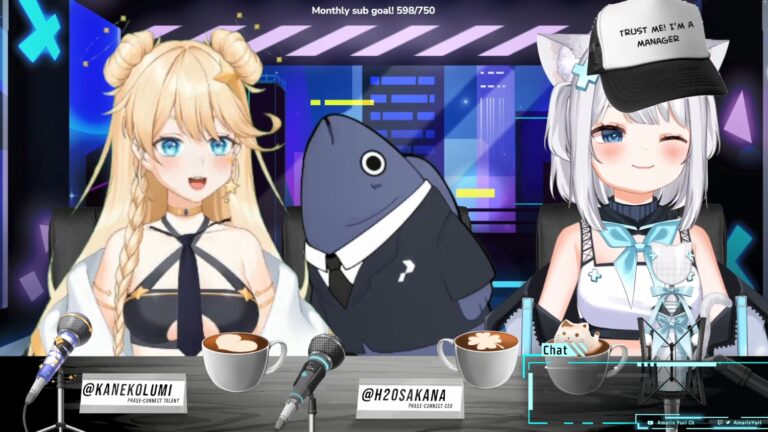Prior to the debut of Phase-Connect’s newest generation Phase/ALiAS on July 9 and 10, Amaris Yuri recently hosted a Questions & Answers session where she read some questions to the agency’s CEO Sakana, with Kaneko Lumi acting as a co-host. For over two hours, Sakana fielded a variety of questions, ranging from his management style to his opinions on the VTubing industry as a whole, while also offering tips for aspiring VTubers.
Sakana was asked about the challenges he faced when he first formed Phase-Connect, and his answer might surprise more than a few people: Because they were new to the scene and unproven, people assumed that they were a scam.
VTubers are often showered with fan art, either art they commission themselves or drawings filled with love and appreciation. Sakana was asked about crediting artists should their art appear in a stream. His explanation was rather simple, and something artists might agree with: Artists should be credited as a general rule. Paid commissions should be credited for the first time, but he clarified that he doesn’t think it’s necessary to credit the artist every single time.
Sakana answered a question related to a VTuber’s profits and explained that, depending on the pay model and agency, it is mostly profit sharing.
Sakana himself has something of a spotlight in the community, having been a target of fake and comical animosity, so he was asked to weigh in on the memes related to him. As a whole, he has no strong opinion on it, but he admitted that it was fun to see. Speaking on the fan art, he said that it could go overboard.
Someone asked Sakana if managers should be more public with their activities or work behind the scenes. The Phase-Connect CEO explained that they can work either in public or private. However, when working in public, activities such as streaming should be done appropriately, and not in a way that could take focus away from the talents. Above all, he insisted that the manager should not be the focus.
Sakana recognized that not every VTuber would want to join an agency, and highlighted some pros and cons to joining. The pros mentioned were a general corporate atmosphere, the protection and growth an agency could offer talents. Restrictions placed on a talent and certain rules to follow were mentioned to be both a pro and a con. These restrictions could protect a VTuber, but a VTuber who wants to be a solo act might not want to join an agency.
VTuber agencies are known to have different generations, groups of VTubers who debut around the same time as each other. When asked how many VTubers should be part of a generation, Sakana insisted on a number between 3 – 7. He said any more would make it just a large group rather than a generation.
When asked if there were any difficulties or differences between launching Gen 1 and Gen 2, Sakana revealed that Gen 1 was launched very quickly and with little planning, while Gen 2 had more time and planning put into it, but certain real-world events delayed the official launch.
Though VTubers around the world have similar styles and methods, Sakana briefly explained what differences he saw between the Western and Japanese VTubing industries. He stated that the Japanese marketing is “difficult and convoluted,” and that the rigging on Japanese VTuber models is a lot less expressive, and has a more anime aesthetic, but with fewer calibrations. He noted that English models are more expressive, which is in higher demand.
The VTubing industry is obviously dominated by female VTubers of all kinds, from pirates to shark girls, though there are a few male VTubers. When asked if he was open to incorporating male talent into Phase-Connect, Sakana replied that he wasn’t at the moment, but that he would monitor the demand for male VTubers going forward before making a decision.
Given the popularity of Twitch and YouTube, and the viability of both as streaming services, Sakana was asked if there would be any greater benefit to streaming on both sites. The fish CEO explained quite carefully that streamers should focus more on whichever site offers the most growth potential. If they insist on streaming to both sites, they should be consistent with their activity.


Participate In Discussions